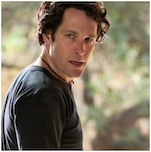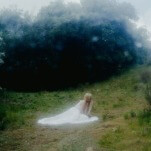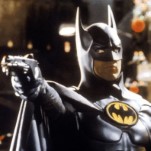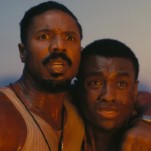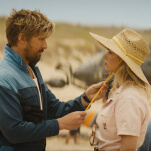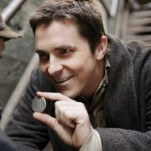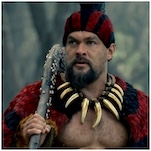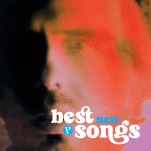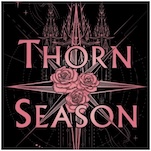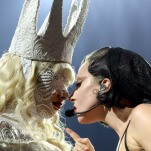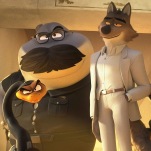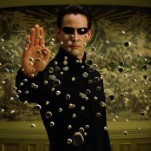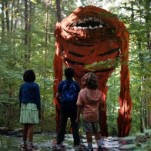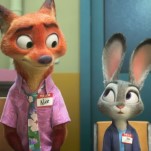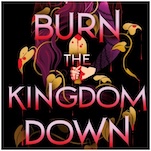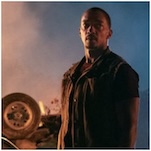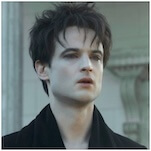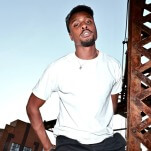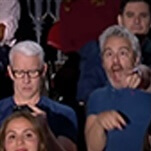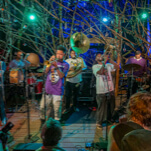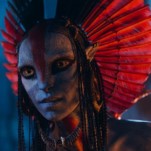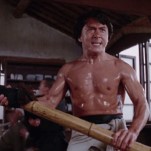Paste: Did having written those sorts of books help you with plotting the mystery aspect of this story, given that it was the one piece you’d sort of done before?
Hodgson: Yeah—I really wanted to do that, to include that, but then I realized…why people don’t do that. [laughter] It’s really hard! Trying to do all the worldbuilding in an epic, and all the action—and I loved writing all the fight scenes—and then having the murder mystery. Just technically trying to make sure that all the elements are there was a real challenge.
Paste: One of the things that hooked me on the book so quickly is that it revels in not doing what you expect this kind of story to do. We don’t meet Neema until chapter four, and there are at least two other characters that the book kind of wants you to think are the main character, until you find out they aren’t. What was the intention behind leading the audience into the story in that way? It’s really different.
Hodgson: I quite like playing with narrative—not just for the sake of it, but because I’ve always enjoyed that as a reader, that kind of pulling the rug out. It’s so easy otherwise ot just settle into what you think is going to happen. But I wanted to be clear that in those first three chapters, where you follow Yana and Ruko, it’s showing you the world of the story, and I wanted to give that introduction some time [to breathe]. But also, you do have to kind of get to know Yana a little bit to understand everything else, especially what Ruko and Neema have done. They’re both characters who have done something really, really…um, unethical, shall we say? But then they’ve both benefited from it as well. How do you recover from that, from making those choices?
In the same way, that’s true even with slightly smaller characters like Shal Worthy, who’s quite damaged by the fact that he had to take Yana through her exile, even though technically, ethically, he did the right thing, he followed his orders. But he’s completely destroyed by that in certain ways. And for the reader to understand all these things and the weight of them, you do need to meet Yana and understand the scope of the betrayals that happen to her.
Paste: I always like playing with narration as a reader as well. But, it seems important to ask—is the Raven a reliable narrator?
Hodgson: I think the Raven thinks it’s reliable. [laughter]. They would always have an answer for things. But you have to listen carefully, because in animal symbolism and mythology, one of the things that ravens are known for is that they’re considered tricksters. Not quite as much as foxes, but there is an element of that, though it’s less overtly harmful. They’ve got their own reality, and their own codes.
Paste: I was going to ask this later, but since we’re on the subject, if you were going to put yourself into one of these animal monasteries, which would it be? I realize this kind of feels like asking what your Hogwarts house is.
Hodgson: The U.K. publishers created a survey so you can answer some questions and find out where you would go. Though I should say, I don’t actually think this is a sensible way of structuring society in real terms. [laughing] And even within the book, people may say, oh, I identify like I’m a Raven, but they can have Ox qualities, it’s a more subtle sort of mix.. Nevertheless, it’s quite fun. And in any case, I was a Raven.
Paste: I was also a Raven. But I’m a Ravenclaw too, so it tracks. But I think a lot of people are going to want to be Foxes.
Hodgson: I was worried that in doing the survey, everyone would just come out to be a Raven. But it really did work, and there’s subtlety to it. And because I know the answers, I can tell you that I’ve got Monkey elements, too, mixed in with a bit of Ox and a bit of Dragon.
Paste: Back to the actual book—Neema is quite unconventional in terms of what we see from typical fantasy heroines right now. In epic fantasy, a lot of leads tend to have the same A-B-C traits or backstories, or are on the same kinds of quests. But Neema is very much not traditional, and I love her so much because of it. What was your kind of North Star in terms of her basic character and her arc over the course of the book?
Hodgson: She’s an interesting mix because she’s incredibly awkward, but she’s always got this underlying self-belief. And she’d say she’s got all these flaws: She always says the wrong thing, she knows she’s really not very good at maintaining friends or relationships. But the way she deals with that is just to admit it. Oh yeah, I’m not very good at friends, you know, like the way some people aren’t very good at singing. She’s got this weird acceptance about it. And then she just sort of gets on with things.
The other thing that was quite important to me when it comes to her is that she’s not too down on herself. She likes her body, she knows she’s good at what she does, and she’s comfortable with herself. One of the first things she says, when Vabras comes in and tells her, “I hear you’ve got the best hand on the island,” she goes, “Yes, I do.” She doesn’t equivocate about it. She knows her worth,
Paste: She doesn’t feel the need to make herself smaller for the sake of the world around her, which is something I particularly appreciate.
Hodgson: Exactly. And even though she’s been bullied at school, she’s had all these bad experiences, she does have this sort of self-confidence in her somewhere. So, she’s a mix. If I’m not making a ton of sense, it’s probably because this is the first time I’ve really spoken about her in detail, outside of my own head.
Paste: Let’s talk about Neema and Cain, whom I desperately love and want to be happy. But I don’t know if I think they can be happy.
Hodgson: Maybe they’re happy not being happy.
Paste: It’s such an intriguing relationship to me because, again, here’s another example of Neema refusing to make herself smaller, to change herself to fit a relationship, even one that she really wants. She and Cain have to figure out how–or if they can—to fit together as they are, which is also something I think that’s not as common as it should be.
Hodgson: That just feels to me like a real relationship struggle people have, you know? They acknowledge it, right in the first scene where you meet them, there’s a little cartoon that Cain’s drawn the two of them. A fox and a raven fighting, then dancing, and then fighting again. And he’s written, ‘Hey, it’s us!’
So there’s a sense of—they both like the verbal play of arguing because they’ve both very bright, but they’re each coming at things from very different perspectives and personalities. They get a lot of energy out of fighting and then puzzling through and how they can then reconnect. Whatever happens to them, they’re not going to stop fighting. It’s not going to suddenly be ‘oh, and then they had a house with a field and everything’s quiet and boring’. There’s always going to be that edge.
Paste: There are so many rich secondary subplots happening in this book outside of Neema’s journey. There’s the Valit family, whose story is so complicated it could probably be a book on its own. There’s Yasila, who gets abandoned on Dragon Island and her life is formed of trauma and her need for revenge could also be its own story. But they’re part of this one—talk to me a little bit about these subplots, and what they mean to the larger story.
Hodgson: Part of it is that you want every character to have a reason why they’re doing what they’re doing that psychologically feels convincing to the reader. Otherwise, it’s just a big book where lots of things are happening and lots of people are doing things to one another. For me, anyway, it’s got to really click. People are complicated. It’s never just one thing that makes them do something. As for Yasila…I would hope by the end of the book you kind of go, oh, this is why she’s like this and that’s why does what she does.
Paste: So much thought clearly went into, say, the Dragon culture versus the Ox culture, versus the Fox culture. How important was it to you to really give these different groups and subcultures their own sort of flavors and history within the larger world of the story? Again, I feel like I could read an entire book about the Dragon Island residents and how they end up the way they are.
Hodgson: I love that. [laughs] That’s probably just my love of fantasy—like you, I always love it when I feel like there’s a hinterland, as though you could go off and have an adventure over there in this other part of the story, this other part of the world.
Paste: There’s so much of this book that feels like the story is still happening when you’re not looking, and in places you’re not aware of. Because to me that’s the sign of a really good, rich world.
Hodgson: Thank you! I’m really glad it feels that way—I did put a lot of effort and thought into the individual monasteries, but honestly, that’s probably because I really enjoyed it.
For me, it’s really fun to go off and think about these things. And once you’ve got the kernel of it, it grows from there, I created little lines for each monastery which felt in keeping with their values and traits. “We pull the plot together” for the Oxen or “To lead first you must follow,” which is something I got from reading about real oxen. Apparently, when they train oxen, they have to teach them to follow before they can lead a team on their own. And that’s where that idea came from.
Paste: Did you have a favorite group to write about or one whose sort of internal voice or culture was most challenging to get a handle on?
Hodgson: I don’t know if it’s a favorite, but I think just in terms of pure enjoyment, the Dragons and the Foxes, really. The Foxes are fun to write and seemed to come very naturally, even though I’m not much like them myself. Maybe that’s part of it—maybe it’s just fun to turn everything upside down the whole time. And then the Dragons, I just like that everything about them is slightly heightened. So writing them feels like you’re going into a quite different mode, there’s more elegance and restraint, and a bit of mystery about what they’re thinking.
Paste: The contenders fighting for the throne probably should feel like little more than cannon fodder. Instead, they’re very three-dimensional figures with their own stories going on, that often have very little to do with Neema directly. Talk to me a little bit about these characters and their roles in this larger story.
Hodgson: Since there are only seven of them, plus the Dragon Proxy, I felt like I really needed to understand not just who they all were but how they would interact with each other in terms of the fights and the trials. I tend to come at things from character, not ‘oh I need this plot to get to Point A”, but, say, if Katsun’s fighting Havoc, how would that work, what would that look like, what would that say about them? It always starts with character.
Paste: I love how they’re so different but yet still all united in hating Ruko. That brings me joy.
Hodgson: It’s even worse because no one can talk about it. So it’s even more isolating in a way. There’s that classic idea that if you can speak about these horrible things, then you can at least slightly excise them. He could have the opportunity to explain himself—not that he ever would, but the possibility that he could is something. So all that hate is just festering inside.
It’s actually the bit that makes the exile so difficult. Well, not for the person who has to [go through the ceremonies]. But for society, I wanted it to feel like this is something that’s beyond shame. It’s…you are erased. Therefore, no one can grieve for you, no one can speak of you. It’s the horror of just being completely forgotten about. This is a story about history as well, it’s about remembering stories. And here’s this punishment where your story is willfully forgotten.
Paste: The Raven is so great, as both a narrator and a character in their own right. Why did you decide to use them to tell this story? Why not Neema, why not anyone other than an infinite number of snotty little birds?
Hodgson: That’s the answer right there. [laughter]. I could have written it purely from Neema’s perspective. My previous series was all first person.
But even within that series, I kept trying to break the rules. I put in little trial documents and things like that, because from a writing point of view, I like playing with narratives. And I think that does come from just the kind of books that I love to read. I love books with footnotes. I love books with chapters that flip between a first-person point of view and then some from a third-person point of view. I like the idea that… just why not? You know, why not? If it serves the story?
So with this, when you have a narrator like the Raven at the center, it allows you to sweep up and sweep back down, in terms of perspective. Or crawl into people’s ribs, as the case may be. And it has a specific place within the order of the Guardians. On the one hand, you have, say, the Fox, who goes out on adventures and is a transgressor and a crosser of boundaries. All of that is Fox symbolism. They’re on the borders, literally, as creatures. Whereas the raven is a story bird. It’s often especially aware of what’s going on around it, and it’s very alert. And the symbolism surrounding ravens says that they are affiliated with the past and the future. So it just made sense to me.
Paste: Did you have a favorite folk tale or piece of mythology that helped inspire or conceptualize writing your own story?
Hodgson: That would be lovely, wouldn’t it, if I could pick one specific thing! I like the adaptability of folk tales. I like the ones where the people go off into the forest to learn something, and I also like the transformation ones where people get turned into something weird.
What I like is that you can have a story, and it’s been told so many different times, it can take different shapes. When you first meet Neema, she’s been writing this probably terminally boring monograph on variants of one folk tale. That’s what interests me—that you could take the Cinderella story, and sometimes it’s very, you know, fluffy, and sometimes it’s not, and the how and why of which version is chosen [to be told].
Paste: Can you tell us anything about the Raven Scholar sequel?
Hodgson: I think—I hope!—it will come out next year. I’m writing away, I’ve written a large portion of the first draft, and then I go back and redraft it quite extensively. But it’s happening, it won’t be a thousand years away or anything.
What can I tell you about it….hmmm, I guess it’s obvious from when you finish The Raven Scholar that a big thing happens, and what follows are the repercussions of that. I can’t really say too much about it, but people are going to have to stand up and decide. What are they going to do about what’s happening?
The first one is contained mainly on the island and over a certain period of time, whereas in the second book, it opens out more, and you’ll get to see more of the Empire. I think I can say that much.
Paste: And my last question that I always ask everyone: What are you reading right now?
Hodgson: Oh, I’ve actually got it right here! It’s called Idolfire by Grace Curtis. And the other one I just finished, but it’s not out for a while yet, is Tessa Gratton’s new book, The Mercy Makers. It’s the start of a new series, and it’s good.
The Raven Scholar is available now wherever books are sold.
Lacy Baugher Milas is the Books Editor at Paste Magazine, but loves nerding out about all sorts of pop culture. You can find her on Twitter and Bluesky at @LacyMB
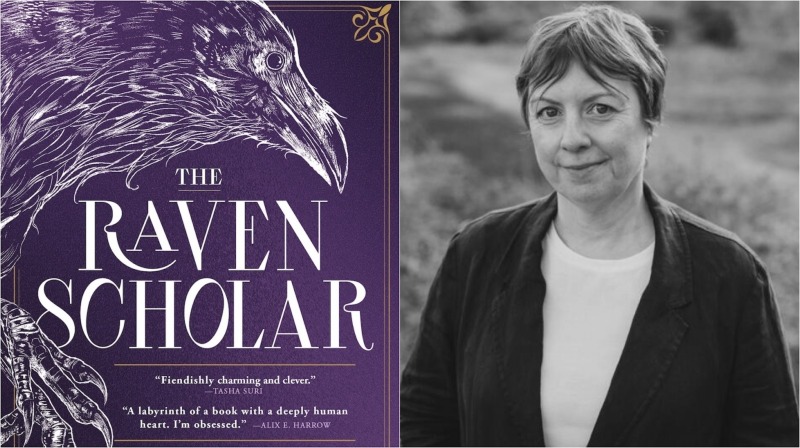
![]()











































